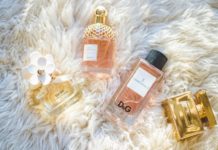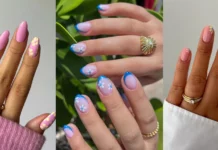Suppose you’ve decided to get a nose piercing, congratulations. This type of piercing can be a fun and expressive way to show off your style and accentuate your face. However, it’s important to ensure you understand the basics before going through with it. Nose piercings, like any other piercing, require careful consideration and research to ensure you end up with a piercing and jewelry combination that you’ll be happy with. Research and understand the potential risks and responsibilities before committing to a nose piercing.
You have many options to choose from there are different types of nose piercing rings, studs, and more. It’s important to research and find the option that best suits you and your style.
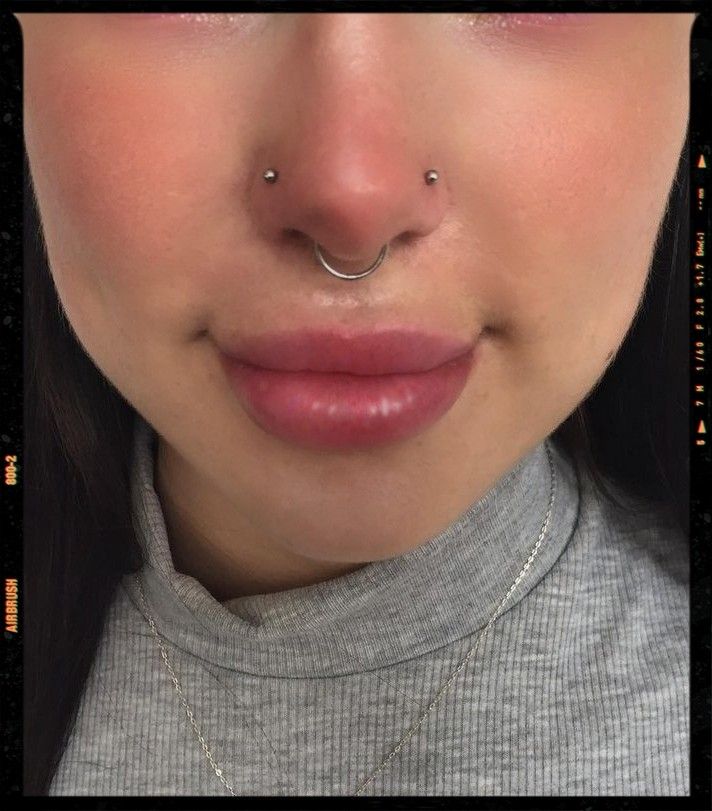
This guide will provide answers to common questions about nose piercings.
If you have any additional questions or are ready to get a nose piercing, consider visiting a reputable piercing parlor with a professional and friendly team, such as those in Newmarket or Mississauga. These parlors often carry a wide selection of high-quality, safe jewelry that will last a long time.
What is a Nose Piercing?
A nose piercing is a type of body modification in which a needle is used to create a hole in the nose through which jewelry can be worn.
Nose piercings are popular for both aesthetic and cultural reasons, and there are many different types of nose piercings to choose from, including nostril piercings, septum piercings, and bridge piercings.
Nose piercings can be made with various materials, including titanium, stainless steel, and gold, and it’s important to select safe and biocompatible jewelry.
Proper aftercare is essential to ensure that the piercing heals properly and without complications.
ALSO READ: Buccal Fat Removal: Procedure, Cost, and Complications
Types of Nose Piercing
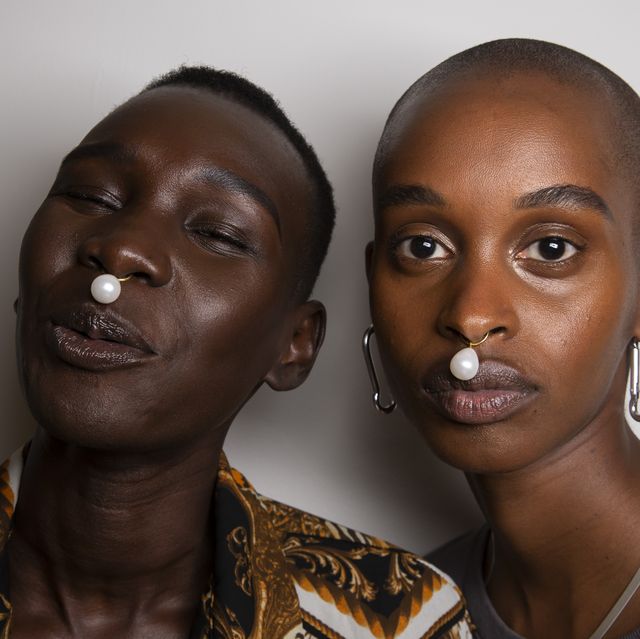
There are many different options to choose from when it comes to nose piercings:
- Nostril piercing: This is the most common type of nose piercing. You can choose a subtle stud or go for a statement piece, but it’s important to avoid rings until the piercing has fully healed.
- Bridge piercing: This piercing involves placing a barbell in the bridge of the nose between your eyes. Keep in mind that this piercing can only be surface-level. With proper aftercare, it can look stunning.
- Septum piercing: This piercing is done in the “sweet spot” between the bottom of the nose and the cartilage. Hoops are the most common choice for this area, but remember that it can be inconvenient when you have a runny nose.
- Nasallang piercing: This piercing goes through the nostril and the septum, giving the appearance of two separate piercings but using a single piece of jewelry.
- High nostril piercing: These piercings are placed higher up on the nostril than traditional nostril piercings and are best suited for studs.
- Vertical nose tip piercing (also known as a “rhino piercing”): This piercing uses a curved barbell where both ends are visible.
- Septril piercing: This piercing involves inserting a curved barbell into the bottom of the nose at the tip. It’s a difficult and painful piercing best suited for those with a plus-sized, healed septum piercing.
ALSO CHECK: DOUBLE NOSE PIERCING: A COMPLETE GUIDE
History of Nose Piercing
Nose piercings have a long history and have been practiced by many different cultures worldwide. The origins of nose piercing are difficult to trace, as many cultures for thousands of years have practiced it.
One of the earliest recorded instances of nose piercing was in ancient India, where it was a traditional practice among Hindu women as a symbol of marriage and fertility. Nose piercings were also common in ancient Egypt, worn by both men and women as a sign of wealth and status.
More recently, nose piercings have been popularized in Western culture by celebrities and fashion trends. In the 1960s and 1970s, nose piercings became associated with counterculture and the hippie movement, and in the 1980s and 1990s, they became more mainstream and were embraced by a wider range of people. Today, nose piercings are a popular form of body modification worldwide.
RELATED: Ear Piercing at Target: The Complete Guide
Nose piercing symbolism
The symbolism of nose piercings can vary depending on cultural and personal context. In some cultures, nose piercings are a traditional practice with symbolic meaning.
For example, in Hindu culture, a nose piercing may symbolize marriage and fertility, while in some Native American cultures, a nose piercing may symbolize social status or spiritual beliefs.
In other contexts, the symbolism of a nose piercing may be more personal and subjective. Some people may view a nose piercing as a form of self-expression or a way to show off their style, while others may see it as a form of rebellion or a way to stand out from the crowd.
Ultimately, the meaning of a nose piercing will depend on the individual’s motivations and cultural context.
ALSO READ: Cute Birthday Nail Designs For Your Special Day Glam
Frequently Asked Questions on Nose Piercing
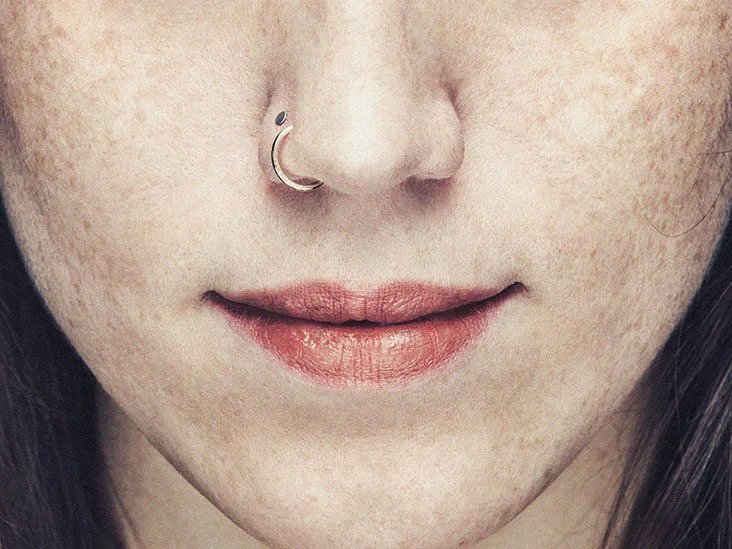
Does Nose Piercing Hurt?
One of the most common questions about nose piercings is the pain involved. Pain tolerance varies from person to person, but it’s important to remember that piercing will involve some discomfort. The piercing process typically takes only a few seconds and may feel like a quick pinch.
However, the area will likely be sore and sensitive afterward and during the healing process. It’s important to remember that while the initial pain from the piercing is over quickly, you may experience some discomfort afterward.
Choose the Safe Metal
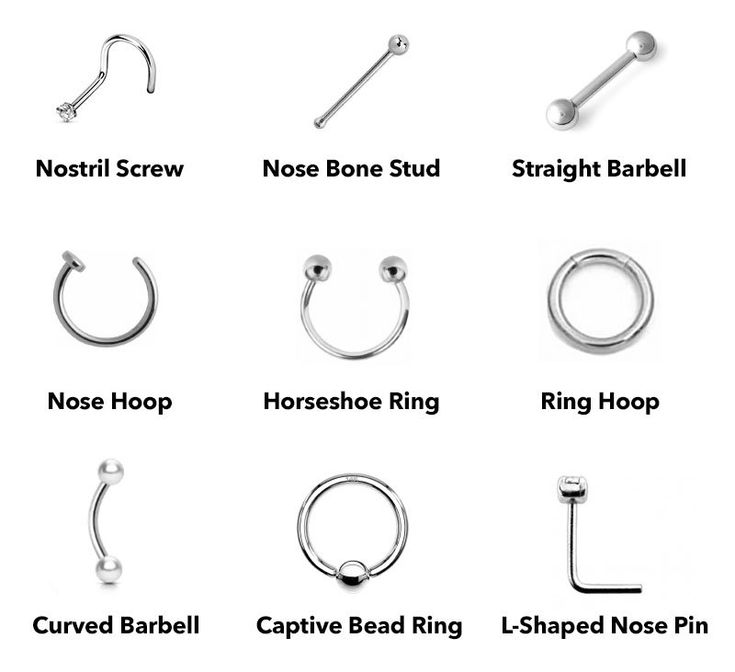
Some people may have sensitivity or allergies to certain jewelry metals, which can cause irritation or mild allergic reactions at the piercing site. If you have sensitive skin or are concerned about potential allergies, there are a few metals that are generally considered safe for nose piercings:
- Surgical stainless steel: This is a relatively affordable metal that most people tolerate well. However, those with sensitive skin may consider titanium instead.
- Implant-grade titanium: This is the safest metal option for nose piercings. It is commonly used in jewelry and is well tolerated by those with sensitive skin.
There are also a few metals that you may want to avoid or approach with caution when it comes to nose piercings:
- Gold: While gold may be suitable for initial piercings if it is 14k or higher, nickel-free, and alloyed for biocompatibility, gold higher than 18k is too soft for body jewelry. Gold-plated, gold-filled, or gold overlay/vermeil jewelry is not recommended for fresh piercings because the thin layer of gold can chip off and become embedded in wounds.
- Nickel: Nickel can cause rashes and should be avoided in jewelry. Some metals, such as surgical and stainless steel, may contain nickel.
- Silver: Silver is a potential allergy risk and can tarnish easily, leaving black marks on the skin around the piercing.
Which Nostril to Pierce
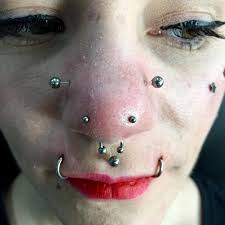
If you’re wondering which nostril to get pierced, here are a few things to consider:
- What side do you part your hair towards? You don’t want to cover up a nose piercing with your hair.
- Which side do you prefer to sleep on? This may affect the healing process.
- Where are your other piercings located? Consider balancing out the distribution of piercings on your body.
If you can’t decide, you can always get both nostrils pierced! Keep in mind that nose piercings are not necessarily permanent, so if you don’t like your piercing, you can always try something new.
Nose Piercing Cost
The cost of a nose piercing can vary depending on many factors, including the location of the piercing studio, the experience level of the piercer, and the type of jewelry being used.
On average, you can expect to pay between $30 and $100 for a nose piercing. However, prices can be higher or lower depending on the specific circumstances.
It’s important to keep in mind that the cost of a nose piercing is not the only factor to consider when choosing a piercing studio.
It’s also important to choose a studio that has a good reputation, uses sterile equipment and safe piercing practices, and has trained experienced piercers.
While it may be tempting to choose the cheapest option, it’s important to prioritize quality and safety to ensure a good piercing experience.
ALSO CHECK: HOW I GOT A MODEL FACECUT WITH THESE V CUT EXERCISE?
Types of Jewelry Used for Nose Piercing
There are a number of different types of jewelry that can be used for a nose piercing, including studs, rings, and barbells.
Some popular options include nostril studs, nostril rings, septum rings, septum clickers, nasallang rings, L-shaped post, nostril screws, straight pins, captive bead rings, seamless rings, bone prongs, and faux hoops.
It’s important to choose a type of jewelry that is comfortable and appropriate for the specific type of nose piercing you have. You should also consider factors such as material and style, as certain metals may be more suitable for sensitive skin and certain styles may be more or less suitable for your personal taste and preferences.
Here are a few common types of jewelry used for nose piercings:
- Studs: Studs are small, simple pieces of jewelry that consist of a straight bar with a ball or decorative top. Studs are a popular choice for nostril piercings and are easy to care for.
- Rings: Rings, also known as hoops, can be worn in a variety of nose piercings, including septum piercings and nostril piercings. Rings come in many different styles and can be worn as either a closed loop or with a removable bead.
- Captive bead rings: Captive bead rings are similar to standard rings, but they have a bead that is held in place by the tension of the ring. These are a popular choice for septum piercings and can be easily removed and changed.
- Barbells: Barbells are another common type of jewelry for nose piercings. They consist of a straight bar with a bead or decorative top on each end. Barbells are often used for bridge piercings and septum piercings.
- L-shaped studs: L-shaped studs are a type of jewelry specifically designed for nostril piercings. They consist of a straight bar with a decorative top and an L-shaped bend at the end. This allows the jewelry to sit flush against the nostril and can be more comfortable to wear than a straight stud.
RELATED: Ashley Piercing aka Lip Piercing: A Complete Guide
Side Effects
Like any body modification, nose piercings can have risks and side effects. Some common nose piercing side effects are pain, redness, warmth, and swelling . Here are a few potential side effects to be aware of:
- Infection: One of the most common risks of a nose piercing is infection. Infections can occur if the piercing equipment is not sterile or if proper aftercare is not followed. Symptoms of infection may include swelling, redness, pain, and discharge.
- Allergic reactions: Some people may be allergic to the materials used in piercing jewelry, such as certain metals. Symptoms of an allergic reaction may include redness, itching, and swelling at the site of the piercing.
- Scarring: It’s possible for a nose piercing to leave a scar, particularly if the piercing is not cared for properly or if it becomes infected.
- Migration or rejection: In some cases, the body may try to push the piercing out (migration) or reject it entirely. This can result in the piercing moving away from the original site or healing over.
- Damage to nasal tissues: If the piercing is not done properly, there is a risk of damage to the nasal tissues, resulting in pain and discomfort.
It’s important to follow proper aftercare instructions and seek medical attention if you experience any unusual symptoms or complications after getting a nose piercing.
Nose Piercing Aftercare
How to Care for Your New Piercing
CLEANING:
Proper care is important to minimize the risk of irritation or infection when it comes to nose piercings. Here’s how to care for your new piercing:
- Cleaning: Proper cleaning is essential to ensure the health of your new piercing. Wash your hands thoroughly before touching the piercing or jewelry.
In the shower, use a pea-sized amount of soap to gently clean the area of the piercing, being careful not to move or twist the jewelry.
Do not force soap inside the wound itself. Rinse the soap off well and dry the piercing using gauze or a paper towel (do not use cloth towels as they can harbor bacteria).
We recommend using Pursan soap or any glycerin-based medical-grade soap without dyes, fragrances, or triclosan.
- Drying: Make sure to dry the piercing thoroughly after cleaning to prevent excess moisture from prolonging the healing process.
- Avoiding irritation: Avoid touching the piercing or rotating the jewelry unnecessarily. Avoid using makeup, lotions, or perfumes near the piercing until it is fully healed.
- Protecting the piercing: If you are participating in activities that may cause the piercing to become dirty or damaged, it’s a good idea to cover the piercing with a bandage or a small piece of gauze secured with medical tape.
- Seeking medical attention: If you experience excessive swelling, redness, discharge, or pain, seek medical attention as soon as possible.
Note: Bar soap isn’t recommended.
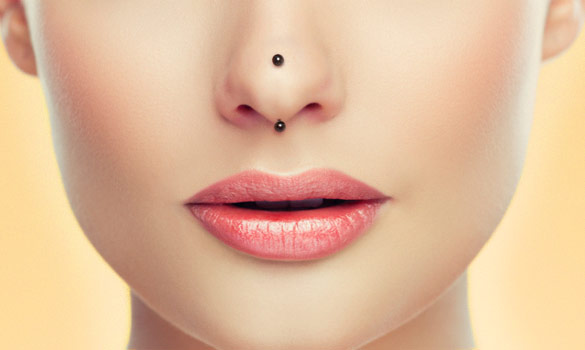
Irrigation is the next step
Irrigation is rinsing off the daily crusties that can form on the front and back of a new piercing. These are normal byproducts of the body, but it’s important to avoid any build-up, which can slow healing and cause complications.
We recommend using Neilmed Saline Spray or an additive-free packaged saline. Avoid using homemade salt mixtures, as too much salt can damage the piercing.
To irrigate the piercing, rinse it for a few minutes and then wipe away any crusties and debris with gauze or a paper towel. Be sure to clean the backs of the jewelry and any settings or prongs.
Irrigation should be done at the opposite end of the day from your shower. Do not remove any scabbing, which should be secured to the site of the wound and painful to remove.
How Long Does It Take A Nose Piercing To Heal?
The healing process for a nose piercing can vary depending on the piercing you have:
- Nostril piercing: 16-24 weeks
- Septum piercing: 12-16 weeks
- Rhino/vertical piercing: 36-48 weeks
- Nasallang piercing: 36-48 weeks
- Bridge piercing: 16-24 weeks
During the healing process, it’s important to follow these guidelines:
- Do not use moisturizer or makeup on the piercing.
- Do not go swimming or expose the piercing to chlorinated water.
- Do not play with or touch the piercing unnecessarily.
- Do not remove the jewelry before the piercing is fully healed.
- Refrain from clearing the piercing.
- Do not change the jewelry before the piercing is fully healed.
Following these guidelines can help ensure that your piercing heals properly and without complications.
What to Keep in mind?
It’s important to pay attention to any issues or abnormalities with your piercing and seek the advice of a trusted local piercer if you have any concerns. Here are a few things to watch out for:
- Migration or embedding: This can occur when the jewelry moves away from the original piercing site or becomes embedded in the skin. Keep an eye on the appearance of your piercing and seek the advice of a piercer if you notice any changes.
- Infection: Signs of infection may include swelling, bleeding, or pus. If you notice any of these symptoms, visit your piercer or a doctor as soon as possible.
- Bumps: Bumps are not necessarily infections but can signify irritation or disruption to the healing process.
If you have any discomfort, bleeding, or unusual symptoms, it’s important to seek the advice of a piercer or a doctor. They will be able to assess the situation and provide guidance on how to proceed.
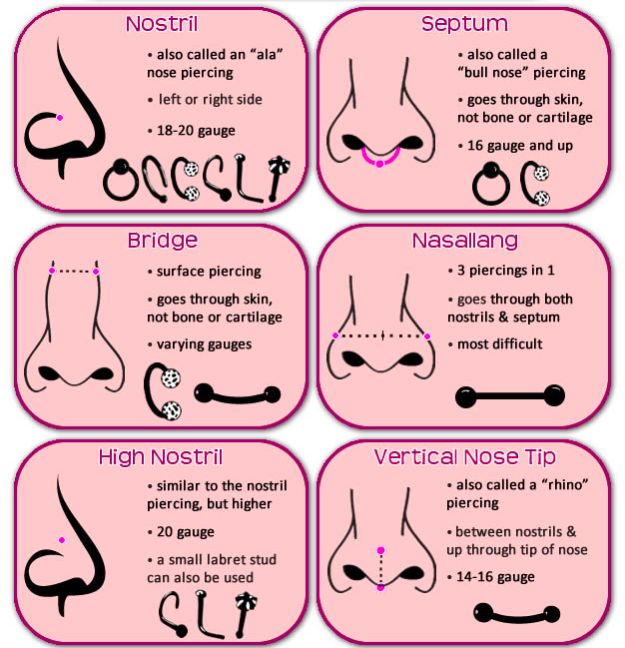
Conclusion
Nose piercings can be a fun and expressive way to show off your style, but it’s important to do your homework and understand the basics before getting one. There are many different types of nose piercings to choose from, and it’s important to consider your options and choose the one that best suits your style and preferences. It’s also important to select jewelry made from safe, biocompatible materials, such as implant-grade titanium or surgical stainless steel.
Proper aftercare is essential to ensure that your piercing heals properly and without complications. Follow the guidelines provided by your piercer, including cleaning the piercing regularly and avoiding activities that could cause irritation or infection. If you notice any unusual symptoms or discomfort, seek the advice of a piercer or a doctor as soon as possible.
FAQs
Can I go for X-rays, CT Scan and MRI with Nose Piercings?
It’s important to keep in mind that metal body jewelry can interfere with certain medical procedures, such as MRI and x-ray. If you have body jewelry and are scheduled to undergo a medical procedure, it’s important to let the medical staff know and follow their instructions regarding the removal of jewelry.
In some cases, it may be necessary to remove the jewelry temporarily, while in other cases, non-metallic retainers can be used to keep the piercing open. It’s also important to note that even momentary removal of jewelry from a piercing can cause the channel to close rapidly, making reinsertion difficult or impossible. It’s important to follow proper aftercare instructions to ensure that your piercing stays healthy and open.
Do The Nose Pierced Hole Heals Itself Naturally?
No, You will need a minor medical procedure to close the nose piercing site.
How Much is A Nose Piercing?
On average, you can expect to pay between $30 and $100 for a nose piercing. However, prices can be higher or lower depending on the specific circumstances.
How Long Does a Nose Piercing Take to Heal?
The length of time it takes for a nose piercing to heal can vary depending on the location of the piercing and the individual’s body. On average, it can take anywhere from 4-12 months for a nose piercing to fully heal. Here are some general healing times for different types of nose piercings:
- Nostril piercing: 4-6 months
- Septum piercing: 3-4 months
- Rhino/vertical piercing: 9-12 months
- Nasallang piercing: 9-12 months
- Bridge piercing: 4-6 months


